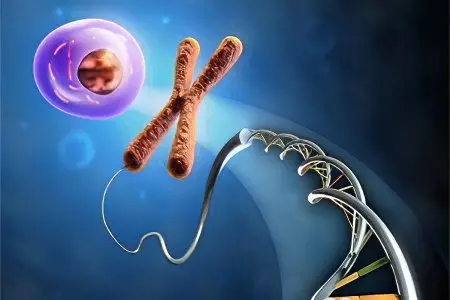Contents

Klinefelter syndrome is one of the most common chromosomal aneuploidies. This anomaly is characteristic only for men and occurs in approximately one in five hundred newborn boys. The syndrome is not fatal and does not create problems during gestation, childbirth and during childhood until puberty, so among the people around there are many suffering from symptoms of a disease that they themselves may not even be aware of.
The discovery of this chromosomal disease was made by Harry Klinefelter and Fuller Albright, who fully described most of the clinical signs in papers dating back to 1942. The anomaly was named after the first of them due to a more significant contribution to the study.
Since then, many minds have been trying to solve the problem of Klinefelter’s syndrome, but so far genetics is not sufficiently developed to treat chromosomal abnormalities, although various methods have been developed to smooth out the main symptoms and improve the social life of carriers of more than two sex chromosomes.
Klinefelter’s syndrome is a polysomy of the sex chromosomes, which is characteristic only for men. Polysomy with different numbers of sex chromosomes occurs with different frequencies:
47 XX;
47 XYY;
48XXYY;
48 XNUMX;
48 XYYY;
49 XXXXY;
49 XXXYY.
These cytogenetic variants can be combined in one organism, which is defined in genetics as mosaicism, due to which some clinical manifestations of chromosomal diseases can be smoothed out or aggravated. The classic Klinefelter syndrome is considered the most common variant – 47 XXY. The frequency of manifestation of this disease in one in five hundred to seven hundred boys has been proven. This is much more common than, for example, congenital pathologies of the adrenal cortex, which occur in only 1 in 10-20 thousand newborns.
Due to the above frequency in 0,2% of the male population, polysomy of the sex chromosomes can be detected in any patient who has the characteristic symptoms of the disease: hypogonadism, erectile dysfunction, infertility and gynecomastia. Therefore, in addition to the genetic nature, Klinefelter’s syndrome is classified as an endocrine pathology, and among them it ranks third in prevalence after diabetes mellitus and various problems with the thyroid gland.
Recent studies of the syndrome give rise to the hypothesis that almost half of all patients with sex chromosome polysomy are not recorded due to the weak manifestation of symptoms. Such patients are usually registered with doctors of other specialties, undergoing treatment for complications caused by neglect and lack of therapy for hypogonadism, its causes and consequences.
Symptoms of Klinefelter’s Syndrome
At an early age, Klinefelter’s syndrome does not give bright manifestations by which it would be possible to detect pathology in a child. The exception is serious mental disorders and mental disorders provoked by Klinefelter’s syndrome, due to which the child does not adapt well in society, may show outbreaks of aggression, becomes withdrawn and apathetic.
Most of the symptoms appear already in adolescence, during puberty. In boys, the mammary glands may swell and increase in size, the hairline is sparse and occurs according to the female type. The most striking of the symptoms is high growth and a specific structure of a figure with a high waist, narrow shoulders and extended hips.
By itself, gynecomastia is not a symptom that unequivocally indicates the presence of Klinefelter’s syndrome – an increase in the mammary glands is observed in more than 60% of male adolescents and disappears on its own after two years. However, in boys with Klinefelter’s syndrome, gynecomastia does not disappear on its own, they need hormone replacement therapy.
The most striking symptom of pathology and one of the few signs that make it possible to determine Klinefelter’s syndrome before the patient reaches the age of puberty is growth. Patients with Klinefelter’s syndrome are usually taller than 185 cm, while they grow most intensively at 5-8 years, which is why they stand out among their peers. For some forms of pathology, high growth is uncharacteristic (with two or three additional X chromosomes), but they often have a number of other striking manifestations.
Patients with Klinefelter’s syndrome have a characteristic appearance: high waist, long arms and legs, arm span rarely exceeds height, and the upper torso is shorter than the lower one.
Other symptoms of the disease:
Sparse and weak hair growth – in men, hair grows poorly on the face and in the armpits, pubic hair is located according to the female type;
Atypical facial structure with features characteristic of pathology – wide-set eyes, there may be strabismus, a wide flattened nose and a half-open large mouth. The auricles are deformed, located low;
Bone anomalies – Many of the bone defects can present at birth. Concave or deformed sternum, micrognathia, high palate and clinodactyly (curvature of the fingers).
The appearance of the genital organs – the penis is underdeveloped, one or both testicles may be absent in the scrotum due to cryptorchidism, their size does not correspond to the norm for healthy men of the same age.
Violations of sexual desire, a significant deterioration in potency in 70% of patients over the age of 25 years.
The mental manifestations of Klinefelter’s syndrome can be very diverse – some children are characterized by unstable behavior, often show aggression and anger, while others, on the contrary, are in a cheerful and high spirits most of the time.
Mental development in Klinefelter’s syndrome may be impaired – many patients experience a decrease in verbal intelligence, which leads to difficulties in mastering school material. Manifestations of the disorder can range from minor difficulties in perceiving and remembering information by ear to a serious developmental delay from peers. Cognitive activity suffers less than verbal, therefore, in general, the IQ of such patients may be average or even much higher than normal.
Children with Klinefelter’s syndrome may be lethargic, prone to depression, and have problems adapting to society. They may experience sudden mood swings, mental lability – from a calm and balanced child suddenly becomes angry and aggressive, after which it can just as suddenly become cheerful and full of enthusiasm. In most cases, acquaintances and relatives of patients describe them as modest, vulnerable and sensitive people who have difficulty making contact with others.
Causes of Klinefelter’s Syndrome

The synthesis of extra chromosomes, as in any polysomy, occurs due to the non-disjunction of already formed chromonemes during the meiotic division of gametes (sex cells), or during the mitotic division of embryonic cells at the stage of the zygote and blastulation of the embryo. According to statistics, the distortion of the genetic material is most often observed in the first variant. Approximately two thirds of all cases of the disease are provoked by an error in oogenesis (formation of the maternal egg and follicular bodies), another third is due to nondisjunction during spermatogenesis (formation of paternal spermatozoa).
The only connection traced in the study of the anamnesis of thousands of patients with Klinefelter’s syndrome was established with the age of the mother (the older, the higher the likelihood of the disease). The age of the father of the child, as it turned out, does not affect the chance of the syndrome. Therefore, prenatal screening is mandatory for old-bearing mothers, although the reason for this is not so much polysomy of sex chromosomes as other aneuploidies that are associated with an increased risk of miscarriage and a possible lethal factor. Unlike most chromosomal diseases, Klinefelter’s syndrome does not affect the birth process and the viability of the newborn, which is why a statistical doubling of the number of patients in the world is expected due to the impossibility of registering all patients.
Diagnosis of Klinefelter’s syndrome
As already mentioned, many (about half) of all cases of sex chromosome polysomy remain undiagnosed due to neglect of prenatal screening due to positive fetal ultrasound results. Such patients are discovered in adulthood when referring to a doctor with problems such as impotence, infertility and breast enlargement (although often even these shortcomings are not considered worthy of a visit to the hospital due to obesity and various prejudices).
The only reliable way to detect a chromosomal abnormality is karyotyping. It is recommended for infertile men with developed mammary glands, as well as for boys with mental deficiencies.
Other symptoms of the syndrome are detected through the following procedures:
Biochemical blood test to detect a decrease in testosterone levels and an increase in follicle-stimulating and luteinizing hormones;
Spermogram to detect reduced activity of spermatozoa or their defectiveness (azoospermia);
Ultrasound examination of the heart to fix malformations of its development;
Densitometry to look for osteoporosis;
Histological examination of obesity in its presence.
Diagnosis of Klinefelter’s syndrome in the prenatal period is made by one of two invasive methods: chorionic biopsy (from 9,5 to 12 weeks of pregnancy) or amniocentesis (from 16 to 18 weeks of pregnancy).
If a future child is found to have polysomy of sex chromosomes, the doctor is obliged not to influence the decision of the mother and fully describe the possible problems of a person with this syndrome and methods for solving them. With early diagnosis of the disease, thanks to a well-planned treatment of hormonal imbalance and other symptoms, significant results can be achieved – to ensure a normal life for a patient with a chromosomal abnormality.
In some cases, when using modern IVF methods, a patient with Klinefelter’s syndrome may have children. As practice and research results show, children from fathers with sex chromosome polysomy are born healthy.
Treatment of Klinefelter’s syndrome
There is no cure for Klinefelter’s syndrome, as is the case with other chromosomal abnormalities. But patients can undergo surgical correction of some external signs of the disease, such as a cleft lip, and they also need hormone replacement therapy due to the lack of natural androgens in the desired concentration.
In general, the quality of life of patients with Klinefelter’s syndrome does not differ in quality from that of healthy people. However, patients with this pathology are more prone to developing obesity and type XNUMX diabetes, osteoporosis, and cardiovascular diseases associated with congenital heart defects.
Some patients have problems with mental activity, which, when progressing, can reduce intelligence to the stage of debility.
A common manifestation of Klinefelter’s symptom for almost all patients is male infertility due to lack of sperm or low viability of spermatozoa. At the same time, men with a mosaic form of the disease can have children if they use IVF technologies.
Therapy for patients with Klinefelter’s syndrome should include therapeutic agents that prevent bone fragility and other pathologies of the musculoskeletal system, hormonal drugs that reduce the risk of developing malignant tumors against the background of gynecomastia.









